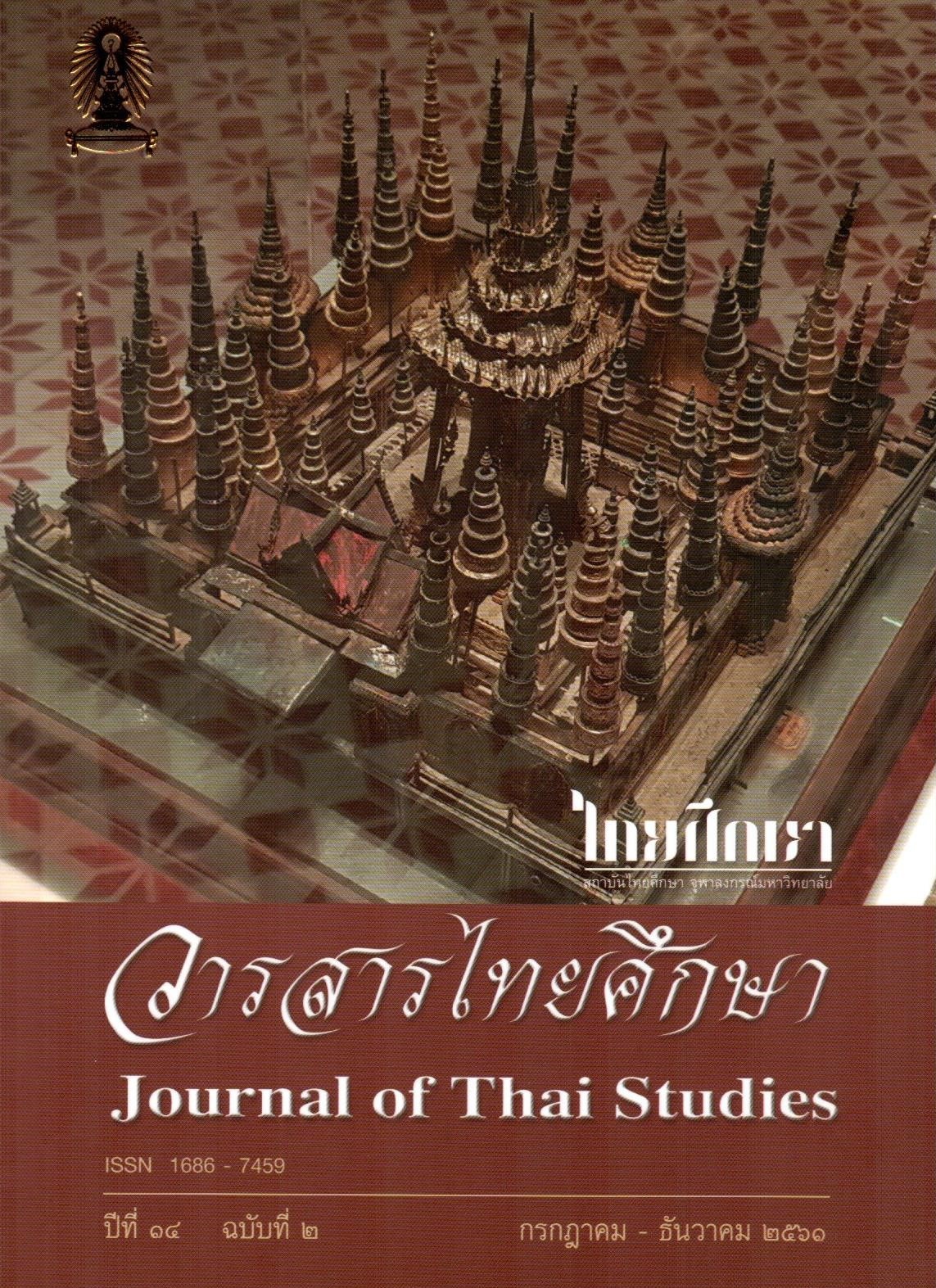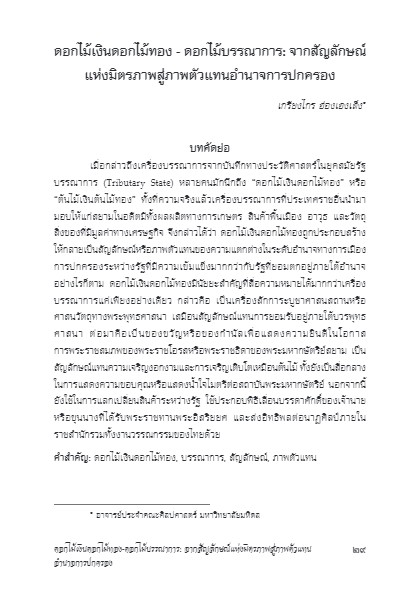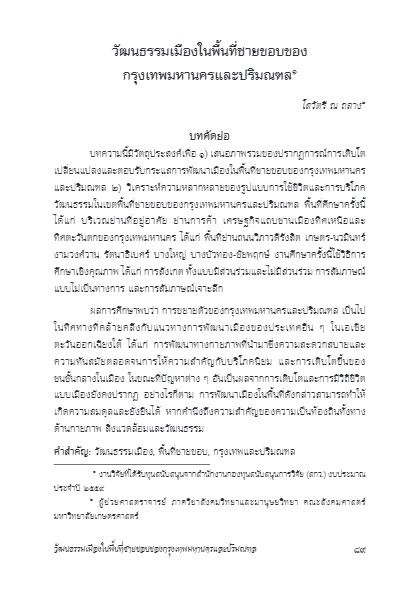วารสารไทยศึกษา - ปีที่ 14 ฉบับที่ 2

1) รัชสมัยแห่งการสร้างทุนมนุษย์ : พระราชกุศโลบายของพระบาทสมเด็จพระจุลจอมเกล้าเจ้าอยู่หัวในการส่งพระราชโอรสไปศึกษาต่อในยุโรป / สุภางค์ จันทวานิช
2) ดอกไม้เงินดอกไม้ทอง – ดอกไม้บรรณาการ: จากสัญลักษณ์แห่งมิตรภาพสู่ภาพตัวแทนอำนาจการปกครอง / เกรียงไกร ฮ่องเฮงเส็ง
3) การวิเคราะห์คำสอนทางพระพุทธศาสนาเพื่อพัฒนาแนวคิดสิทธิมนุษยชน / ภาณุทัต ยอดแก้ว
4) วัฒนธรรมเมืองในพื้นที่ชายขอบของกรุงเทพมหานครและปริมณฑล / โสวัตรี ณ ถลาง
5) การมาเยือนของหญิงชรา : ปฏิบัติการสร้างสรรค์ละครฝรั่งเพื่อผู้ชมไทย / อาทรี วณิชตระกูล
6) “เมื่อเกิดมาเป็นสตรี จะสงวนประเวณีให้แจ่มใส”: การนำเสนอตัวละครหญิงเพื่อสอนหญิงในเรื่องดาหลังพระราชนิพนธ์รัชกาลที่ 1 / ธานีรัตน์ จัตุทะศรี
รัชสมัยแห่งการสร้างทุนมนุษย์ : พระราชกุศโลบายของพระบาทสมเด็จพระจุลจอมเกล้าเจ้าอยู่หัวในการส่งพระราชโอรสไปศึกษาต่อในยุโรป
สุภางค์ จันทวานิช
บทคัดย่อ
ในรัชสมัยของพระบาทสมเด็จพระจุลจอมเกล้าเจ้าอยู่หัว ได้มีการส่งพระราชโอรสจำนวน 20 พระองค์ไปศึกษาต่อในยุโรประหว่างปี พ.ศ. 2428-2449 พระบาทสมเด็จพระจุลจอมเกล้าเจ้าอยู่หัว มีพระราชปณิธาน ที่จะพัฒนาสยามประเทศให้เจริญก้าวหน้าทัดเทียมอารยประเทศทั้งในแง่การปกครอง การขยายสาธารณูปโภค การปฏิรูประบบและสถาบันต่าง ๆ เช่น กฎหมาย การศึกษา การเกษตร ฯลฯ พระราชโอรสได้เสด็จไปศึกษาโดยทุนจากพระราชทรัพย์ส่วนพระองค์ของรัชกาลที่ 5 ตั้งแต่ชั้นมัธยมที่ประเทศอังกฤษ แล้วทรงศึกษาต่อในสาขาวิชาที่สนพระทัย ได้แก่ กฎหมาย เศรษฐศาสตร์ การทหาร วิศวกรรม การเกษตร ศิลปศาสตร์ และอักษรศาสตร์ รัฐศาสตร์ การศึกษา แพทยศาสตร์ และสถาปัตยกรรมในประเทศอังกฤษ เยอรมัน ฝรั่งเศส และรัสเซีย เมื่อทรงสำเร็จการศึกษาได้เดินทางกลับมาประเทศไทย และได้มีบทบาทสำคัญในการปฏิรูป ในด้านระบบราชการสมัยใหม่ การทหารสมัยใหม่ การขยายโครงสร้างพื้นฐานและสาธารณูปโภคที่จำเป็นสำหรับการพัฒนาประเทศ และการปฏิรูประบบกฎหมาย การเกษตร การคลัง สาธารณสุข และการศึกษา นับเป็นการสร้างทุนมนุษย์ที่มีคุณูปการอย่างยิ่งแก่สังคมไทยในเวลาต่อมา
คำสำคัญ : พระบาทสมเด็จพระจุลจอมเกล้าเจ้าอยู่หัว, พระราชโอรส, การศึกษาต่อในยุโรป, การสร้างทุนมนุษย์
(ตีพิมพ์ใน วารสารไทยศึกษา ปีที่ 14 ฉบับที่ 2 (กรกฎาคม – ธันวาคม 2561) หน้า 1-28)
The Reign of Human Capital Accumulation : King Chulalongkorn’s Policy in Sending His Sons to Study in Europe
Supang Chantavanich
Abstract
During the reign of King Chulalongkorn, twenty of his sons were sent to continue their studies in Europe during 1885-1906. The King had a resolution to modernize Siam in many fields, including administration, infrastructure development, as well as reforms in the judicial, education and agricultural sectors. The Siamese princes were sponsored by King Chulalongkorn’s own funds to study from public school level to university level. The fields of study covered law, economics, military, engineering, agriculture, liberal arts, political science, education, medical science and architecture in England, Germany, France and Russia. After graduation, all the princes returned to Siam and became significant driving forces in the reform of the nation. Modern bureaucracy, Western army, expansion of infrastructure (roads, railways, canals) and public utilities (water) necessary for development, as well as reforms in law, finance, education, public health and agriculture, were put in place. King Chulalongkorn’s investment in human capital accumulation through the international migration of his sons to Europe proved important in modernizing Thailand.
Keywords : King Chulalongkorn, Sons of King Chulalongkorn, International migration in Europe, human capital accumulation
(Published in Journal of Thai Studies Volume 14 Number 2 (July – December 2018) Page 1-28)
บทความ / Full Text : Download
ดอกไม้เงินดอกไม้ทอง - ดอกไม้บรรณาการ: จากสัญลักษณ์แห่งมิตรภาพสู่ภาพตัวแทนอำนาจการปกครอง
เกรียงไกร ฮ่องเฮงเส็ง
บทคัดย่อ
เมื่อกล่าวถึงเครื่องบรรณาการจากบันทึกทางประวัติศาสตร์ในยุคสมัยรัฐบรรณาการ (Tributary State) หลายคนมักนึกถึง “ดอกไม้เงินดอกไม้ทอง” หรือ “ต้นไม้เงินต้นไม้ทอง” ทั้งที่ความจริงแล้วเครื่องบรรณาการที่ประเทศราชอื่นนำมามอบให้แก่สยามในอดีตมีทั้งผลผลิตทางการเกษตร สินค้าพื้นเมือง อาวุธ และวัตถุ สิ่งของที่มีมูลค่าทางเศรษฐกิจ จึงกล่าวได้ว่า ดอกไม้เงินดอกไม้ทองถูกประกอบสร้างให้กลายเป็นสัญลักษณ์หรือภาพตัวแทนของความแตกต่างในระดับอำนาจทางการเมืองการปกครองระหว่างรัฐที่มีความเข้มแข็งมากกว่ากับรัฐที่ยอมตกอยู่ภายใต้อำนาจ อย่างไรก็ตาม ดอกไม้เงินดอกไม้ทองมีนัยยะสำคัญที่สื่อความหมายได้มากกว่าเครื่องบรรณาการแค่เพียงอย่างเดียว กล่าวคือ เป็นเครื่องสักการะบูชาศาสนสถานหรือศาสนวัตถุทางพระพุทธศาสนา เสมือนสัญลักษณ์แทนการยอมรับอยู่ภายใต้บวรพุทธศาสนา ต่อมาคือเป็นของขวัญหรือของกำนัลเพื่อแสดงความยินดีในโอกาสการพระราชสมภพของพระราชโอรสหรือพระราชธิดาของพระมหากษัตริย์สยาม เป็นสัญลักษณ์แทนความเจริญงอกงามและการเจริญเติบโตเหมือนต้นไม้ ทั้งยังเป็นสื่อกลางในการแสดงความขอบคุณหรือแสดงน้ำใจไมตรีต่อสถาบันพระมหากษัตริย์ นอกจากนี้ ยังใช้ในการแลกเปลี่ยนสินค้าระหว่างรัฐ ใช้ประกอบพิธีเลื่อนบรรดาศักดิ์ของเจ้านายหรือขุนนางที่ได้รับพระราชทานพระอิสริยยศ และส่งอิทธิพลต่อนาฏศิลป์ภายในราชสำนักรวมทั้งงานวรรณกรรมของไทยด้วย
คำสำคัญ : ดอกไม้เงินดอกไม้ทอง, บรรณาการ, สัญลักษณ์, ภาพตัวแทน
(ตีพิมพ์ใน วารสารไทยศึกษา ปีที่ 14 ฉบับที่ 2 (กรกฎาคม – ธันวาคม 2561) หน้า 29-60)
The Golden and Silver Flowers – The Tributary Flowers: from a Symbol of Friendship to a Representation of Authority
Kriangkrai Honghengseng
Abstract
When discussing tributary offerings that appeared in historical records in the tributary state period, many may think of “golden and silver flowers or trees”, despite the fact that there were other kinds of the tributes that the tributary states offered to Siam, such as produce, local products, weapons and other economically valuable objects. It can be said that golden and silver flowers were construed as a symbol or a representation of political unevenness between the superior and the inferior states. Nevertheless, golden and silver flowers were more significant than being only a tribute – they became items of worship to religious objects and places, symbolizing becoming a Buddhist. They were later a gift or a tribute to felicitate the birth of a prince or princess, symbolizing the growth of the tree. They were also used for the sake of showing gratitude or royalty to the monarchy and for bartering commodity between countries. Finally, they were used in accolades or aggrandizement of the nobility or the investiture of a royal title. They also influenced Thai royal-court performing arts and literature.
Keywords : Golden and Silver Flowers; Tribute; Symbol; Representation
(Published in Journal of Thai Studies Volume 14 Number 2 (July – December 2018) Page 29-60)
บทความ / Full Text : Download
การวิเคราะห์คำสอนทางพระพุทธศาสนาเพื่อพัฒนาแนวคิดสิทธิมนุษยชน
ภาณุทัต ยอดแก้ว
บทคัดย่อ
งานวิจัยนี้มุ่งหมายที่จะสร้างรูปแบบเพื่อใช้เป็นระบบจริยศาสตร์สิทธิมนุษยชนแนวพุทธที่สามารถไปไดกั้บคำสอนของพระพุทธเจ้า โดยการพิจารณาข้อเสนอหลักธรรมของบรรดานักวิชาการที่มีชื่อเสียงในระดับโลก เช่น ศาสตราจารย์เดเมียน คีโอน (Damein Keown) ศาสตราจารย์เจ แอล การ์ฟิลด์ (Jay L. Garfield) ศาสตราจารย์แพทริค เฮเดน (Patrick Hayden) พระพีเรรา (L. P. N. Perera) ในบทความนี้ ภาณุทัต ยอดแก้วเห็นว่าทั้งสิทธิมนุษยชนและคำสอนทางพระพุทธศาสนาคล้ายคลึงกันในแง่ที่ว่าทั้งสองระบบส่งเสริมสันติภาพและการเคารพศักดิ์ศรีแห่งความเป็นมนุษย์ จึงเป็นเรื่องที่น่าสนใจเพื่อดูว่า เราสามารถสร้างแนวคิดสิทธิมนุษยชนในคำสอนทางพระพุทธศาสนาได้ขนาดไหน ผลการวิจัยแสดงว่า ตามบทวิเคราะห์ของพระสงฆ์เถรวาทของไทยที่เคยเขียนประเด็นสิทธิมนุษยชน เช่น พุทธทาสภิกขุ สมเด็จพระพุทธโฆษาจารย์ (ปอ.ปยุตฺโต) และพระมหาวุฒิชัย วชิรเมธี เห็นว่า แนวคิดสิทธิมนุษยชนได้ถูกสร้างขึ้นเพื่อสะท้อนความกังวลใจของโลกเกี่ยวกับสันติภาพและสุขภาวะของมนุษย์ในช่วงหลังการสิ้นสุดลงของสงครามโลกครั้งที่สอง แต่สิทธิมนุษยชนนั้นยังไม่มีความดีระดับสูง หรือ “สัมมาปัญญา”
งานวิจัยนี้พบว่าหากพิจารณาตามแนวคิดนิติปรัชญาตะวันตกที่เห็นว่าหน้าที่สร้างสิทธิ์ หน้าที่ดังที่สะท้อนอยู่ในมัชฌิมาปฏิปทาก็สามารถสร้างสิทธิ์และเสรีภาพได้อย่างไม่มีขอบเขต มัชฌิมาปฏิปทาสามารถช่วยเสริมคุณค่าในเรื่องความดีระดับสูงหรือแม้แต่พัฒนาหรือเติมเต็มแนวคิดสิทธิมนุษยชน การบูรณาการปฏิญญาสากลว่าด้วยสิทธิมนุษยชนของสหประชาชาติกับพุทธธรรมจึงถูกเสนอในนี้ในฐานะอีกทางเลือกทางทฤษฎีสำหรับสังคมพุทธ
คำสำคัญ : สิทธิมนุษยชน, พระพุทธศาสนา, วาทกรรม, มัชฌิมาปฏิปทา, มรรคมีองค์ 8, ไตรสิกขา, การบูรณาการ
(ตีพิมพ์ใน วารสารไทยศึกษา ปีที่ 14 ฉบับที่ 2 (กรกฎาคม – ธันวาคม 2561) หน้า 61-88)
An Analysis of Buddhist Teachings for Developing the Concept of Human Rights
Panutat Yodkaew
Abstract
The article aims to create a Buddhist model of human rights by taking into consideration analyses given by world-famous scholars on the topic of “human rights and Buddhism”, such as Damein Keown, Jay L. Garfield, Patrick Hayden, and Perera. The author argues that the concept of human rights is similar to Buddhist teachings in that both are intended to promote peace and respect for human dignity. The research findings show that according to commentary given by Thailand’s leading Buddhist monks on the modern concept of human rights, the concept of human rights is well structured to express global concerns over human peace and wellbeing following the end of World War II, but is still devoid of what can be considered “the highest echelons of goodness/virtue” equivalent to the Buddhist notion of Samma Paññā.
The research findings reveal that based on a Western legal philosophical notion that duties entail rights, it is the duties echoed in the Buddhist concept of the Middle Path that can lead to unlimited rights and freedom. The Middle Path is found to be able to complement or even add the value of Buddhist ultimate good to the modern concept of human rights. Integration of the UN Universal Declaration of Human Rights, with some doctrines selected from the Buddhadhamma, has been proposed as another theoretical option for Buddhist society.
Keywords : Human Rights, Buddhism, Discourse, the Middle Path, Threefold Learning, Integration
(Published in Journal of Thai Studies Volume 14 Number 2 (July – December 2018) Page 61-88)
บทความ / Full Text : Download
วัฒนธรรมเมืองในพื้นที่ชายขอบของกรุงเทพมหานครและปริมณฑล
โสวัตรี ณ ถลาง
บทคัดย่อ
บทความนี้มีวัตถุประสงค์เพื่อ 1) เสนอภาพรวมของปรากฏการณ์การเติบโต เปลี่ยนแปลงและตอบรับกระแสการพัฒนาเมืองในพื้นที่ชายขอบของกรุงเทพมหานครและปริมณฑล 2) วิเคราะห์ความหลากหลายของรูปแบบการใช้ชีวิตและการบริโภควัฒนธรรมในเขตพื้นที่ชายขอบของกรุงเทพมหานครและปริมณฑล พื้นที่ศึกษาครั้งนี้ ได้แก่ บริเวณย่านที่อยู่อาศัย ย่านการค้า เศรษฐกิจแถบชานเมืองทิศเหนือและทิศตะวันตกของกรุงเทพมหานคร ได้แก่ พื้นที่ย่านถนนวิภาวดีรังสิต เกษตร-นวมินทร์ งามวงศ์วาน รัตนาธิเบศร์ บางใหญ่ บางบัวทอง-ชัยพฤกษ์ งานศึกษาครั้งนี้ใช้วิธีการศึกษาเชิงคุณภาพ ได้แก่ การสังเกต ทั้งแบบมีส่วนร่วมและไม่มีส่วนร่วม การสัมภาษณ์แบบไม่เป็นทางการ และการสัมภาษณ์เจาะลึก
ผลการศึกษาพบว่า การขยายตัวของกรุงเทพมหานครและปริมณฑล เป็นไปในทิศทางที่คล้ายคลึงกับแนวทางการพัฒนาเมืองของประเทศอื่น ๆ ในเอเชียตะวันออกเฉียงใต้ ได้แก่ การพัฒนาทางกายภาพที่นำมาซึ่งความสะดวกสบายและความทันสมัยตลอดจนการให้ความสำคัญกับบริโภคนิยม และการเติบโตขึ้นของชนชั้นกลางในเมือง ในขณะที่ปัญหาต่าง ๆ อันเป็นผลจากการเติบโตและการมีวิถีชีวิตแบบเมืองยังคงปรากฏ อย่างไรก็ตาม การพัฒนาเมืองในพื้นที่ดังกล่าวสามารถทำให้เกิดความสมดุลและยั่งยืนได้ หากคำนึงถึงความสำคัญของความเป็นท้องถิ่นทั้งทางด้านกายภาพ สิ่งแวดล้อมและวัฒนธรรม
คำสำคัญ : วัฒนธรรมเมือง, พื้นที่ชายขอบ, กรุงเทพและปริมณฑล
(ตีพิมพ์ใน วารสารไทยศึกษา ปีที่ 14 ฉบับที่ 2 (กรกฎาคม – ธันวาคม 2561) หน้า 89-123)
Urban Culture in the Marginal Areas of Bangkok and the Periphery
Sowatree Nathalang
Abstract
The purposes of this article are 1) to present holistically urban growth and changes relevant to current urban development in the marginal areas of Bangkok and the periphery and 2) to analyze the diversity of people’s pattern of life and cultural consumption in such areas. The area of this study includes residential, economic and commercial areas located in the northern and western part of Bangkok, i.e Vipawadee Rangsit, Kaset-Nawamin, Ngamwongwan, Rattanaitbet, Bang Yai and Bangbuathong-Chaiyapreuk junctions. A qualitative method, including participant and non-participant non-formal and in-depth interviews, was used.
The study reveals that the expansion of Bangkok and the periphery is relevant to the trend of urban development in Southeast Asian countries. Such physical development leads to comfort and modernity, including concentration of consumerism and the increase of the urban middle class; whereas diverse problems caused by urban growth and urbanism as a way of life still persist. However, urban development in such areas could be balanced and sustainable if localism in physical, environmental and cultural aspects is stressed.
Keywords : urban culture, marginal area, Bangkok and periphery
(Published in Journal of Thai Studies Volume 14 Number 2 (July – December 2018) Page 89-123)
บทความ / Full Text : Download
การมาเยือนของหญิงชรา : ปฏิบัติการสร้างสรรค์ละครฝรั่งเพื่อผู้ชมไทย
อาทรี วณิชตระกูล
บทคัดย่อ
บทความวิจัยนี้เป็นงานวิจัยบนฐานปฏิบัติการที่มุ่งแสวงหากระบวนการสร้างสรรค์งานละคร มีวัตถุประสงค์เพื่อศึกษาการดัดแปลงบทละครที่เป็นวรรณกรรมการละครตะวันตกเรื่อง เดอะ วิสิท โดยใช้คำสอนของพุทธศาสนาเรื่องกิเลสตัณหาและเรื่องกรรมเป็นหลักในการดัดแปลง และเพื่อศึกษาการกำกับการแสดงละครเรื่องการมาเยือนของหญิงชรา โดยใช้แนวทางละครแบบเอ็กซ์เพรสชั่นนิสม์ การดำเนินงานแบ่งเป็น 2 ส่วน ได้แก่ การดัดแปลงบทละครและการกำกับการแสดงละคร ผลของการดำเนินงานพบว่าผู้ชมไทยเข้าใจแก่นความคิดหลักของเรื่องและเข้าใจภาวะกดดันของตัวละครที่สื่อออกมาได้ตามวัตถุประสงค์ ทำให้สรุปได้ว่าผู้ชมสามารถเข้าใจละครที่เป็นวรรณกรรมการละครตะวันตกได้เนื่องจากบทละครมีแก่นความคิดที่เป็นสากล ทั้งยังได้มีการสร้างสรรค์ปฏิบัติการทางละครเพื่อเอื้อให้ผู้ชมเข้าใจละครได้ดียิ่งขึ้น
คำสำคัญ : การดัดแปลงบทละคร, การกำกับการแสดง, ละครตะวันตก, วรรณกรรมการละคร, พุทธศาสนา
(ตีพิมพ์ใน วารสารไทยศึกษา ปีที่ 14 ฉบับที่ 2 (กรกฎาคม – ธันวาคม 2561) หน้า 125-150)
Kan Ma Yuean Khong Ying Cha-ra : Creative Process of Making Western Plays for Thai Audiences
Arthri Vanichtrakul
Abstract
The aim of this practiced based research was to explore the creative theatrical process. The objectives of the research were to examine a play script based on the original Western dramatic literature, The Visit, which was adapted using Buddhist doctrines of lustful desires and karma, and to explore the stage directing of the adapted script Kan Ma Yuean Khong Ying Cha-ra that applied expressionist techniques. Thus, the working processes consisted of two stages, the script adaptation and the play direction. The findings reveal that Thai audiences can understand the theme of the play and also the agony of the characters. In conclusion, presenting this play based on Western dramatic literature could be understood by Thai audiences as the literature’s theme is universal and several creative theatrical methods were applied for a better understanding by the audience.
Keywords : script adaptation, play directing, western theatre, dramatic
literature, Buddhism
(Published in Journal of Thai Studies Volume 14 Number 2 (July – December 2018) Page 125-150)
บทความ / Full Text : Download
“เมื่อเกิดมาเป็นสตรี จะสงวนประเวณีให้แจ่มใส”: การนำเสนอตัวละครหญิงเพื่อสอนหญิงในเรื่องดาหลังพระราชนิพนธ์รัชกาลที่ 1
ธานีรัตน์ จัตุทะศรี
บทคัดย่อ
บทความนี้มุ่งศึกษาลักษณะการนำเสนอตัวละครหญิงในเรื่องดาหลัง พระราชนิพนธ์รัชกาลที่ 1 และศึกษาคำสอนหญิงจากการนำเสนอตัวละครดังกล่าว ผลการศึกษาพบว่า เรื่องดาหลังนำเสนอตัวละครหญิงให้เป็นภาพสะท้อนของผู้หญิงหลากหลาย “แบบ” ทั้งที่เป็นไปตามอุดมคติและไม่เป็นไปตามอุดมคติ การนำเสนอดังกล่าวมีบทบาทในการสอนผู้หญิงเรื่องการครองตนอย่างชัดเจน โดยแสดงให้เห็นลักษณะของผู้หญิงที่พึงเป็นและผู้หญิงที่ไม่พึงเป็น ซึ่งสอดคล้องกับมโนทัศน์เรื่องผู้หญิงที่ปรากฏในนิทานปันหยีบางสำนวนและวรรณคดีคำสอนหญิงเรื่องต่าง ๆ ของไทย คำสอนที่นำเสนอผ่านตัวละครหญิงดังกล่าว จึงช่วยเสริมคุณค่าและความสำคัญของเรื่องดาหลังในฐานะวรรณคดีคำสอนหญิงเรื่องหนึ่ง
คำสำคัญ : ดาหลัง, ตัวละครหญิง, การนำเสนอ, คำสอนหญิง
(ตีพิมพ์ใน วารสารไทยศึกษา ปีที่ 14 ฉบับที่ 2 (กรกฎาคม – ธันวาคม 2561) หน้า 151-198)
“Once one is born a woman, she should be careful to preserve her purity”: Representation of Female Characters as Lessons for Women in Dalang by King Rama I
Thaneerat Jatuthasri
Abstract
This paper studies the representation of female characters in Dalang by King Rama I and examines the lessons for women, reflecting on their representation. The study finds that the female characters in Dalang represent various types of woman in relation to and opposite to the ideal qualities of women. Such representation explicitly indicates life lessons for women with regard to what a woman should and should not be. Those lessons harmonize with the concept of womankind expressed in some Panji stories and Thai female didactic literature. Lessons for women expressed through the representation of female characters enhance the value and significance of Dalang as a female didactic literary work.
Keywords : Dalang; female characters; representation; lessons for women
(Published in Journal of Thai Studies Volume 14 Number 2 (July – December 2018) Page 151-198)
บทความ / Full Text : Download






